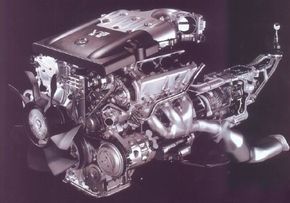350Z Engine Design
The heart and soul of any sports car is its engine. For Nissan's most-famous series, that has traditionally meant six cylinders; a high-strung, peaky four cylinder would not do for the 350Z engine design.
The 350Z engine design needed to offer both good low-end torque for powerful acceleration from a standing start and excellent top-end breathing for high-speed merging and passing. Around-town drivability was important. No lumpy cams or hair-trigger turbos would do.
Advertisement
To meet these demands, Nissan wisely chose to power the 350Z with the third-generation version of its VQ V-6. Aside from the 350Z, the VQ has been used in the Nissan Altima, Maxima, and Pathfinder, as well as the Infiniti I35, G35, and QX4. About half a million VQ engines are assembled annually at Nissan's Iwaki Engine Plant, a factory that's been called the most-advanced of its kind in the world.
Nissan began planning for a front mid-ship application of this engine in 1996. From the start, the goal was to achieve high performance in a compact package. The engine would have to be narrow to work in a longitudinal orientation with multi-link front suspension. And it needed to be short so its center of gravity could be located aft of the front-wheel centerline, front mid-ship style, and not intrude unduly into the passenger compartment.
To help get the sort of effortless power deemed appropriate for a Z, engineers gave this iteration of the VQ engine a relatively high displacement. Bore size for the Z, introduced as a 2002 model, was actually larger than 2002 Q45's 4.5-liter V-8, and nearly as big as the pistons in the 2002 Corvette's 5.7-liter V-8.
The 350Z's engine was also more of an oversquare design than that of the last 300ZX; the new V-6 used a 95.5-mm bore and 81.4-mm stroke, compared to an 87.0-mm bore and 83.0-mm stroke on the 300ZX.
To further boost power, engineers worked to get more air in and out of the VQ engine. They redesigned the intake ports for better flow, increased valve lift and reduced exhaust-system back pressure. High-flow, a straight intake, and equal-length runners allowed free breathing.
A fairly high 10.3:1 compression ratio was chosen to enhance low-speed torque for good launch. By incorporating a knock sensor, the car ran acceptably on low-octane fuel, though optimum performance could only be obtained using premium-grade gas, which Nissan recommended.
For more on Nissan Zs and other great sports cars, check out:
- Nissan Z
- Sports Cars
- Porsche Cars
- Ferrari
